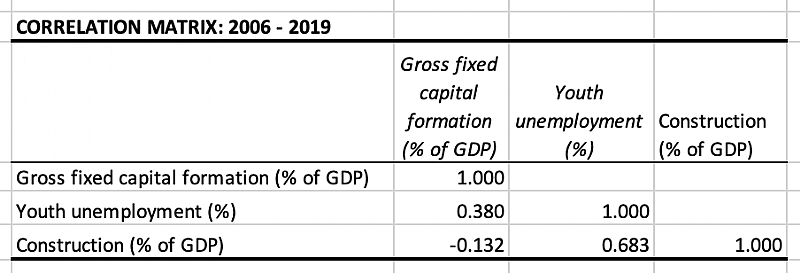Youth unemployment is a major issue and a security concern in Ghana. According to the International Labour Organisation (ILO), total youth unemployment (% of total labour force ages 15 - 24) was 8.72% in 2019, which is actually lower than the rate for the previous years (8.78% in 2018 for instance). The rate of youth unemployment peaked in 2015 at 14.17% between 2007 - 2019 period and began declining from then (see chart below).

Despite the decline in the unemployment rate, stakeholders continue to express concern about the matter. Recently, the Finance Minister, Ken Ofori-Atta, was reported to have suggested that government payroll was full, and as a result, there was no space for employment of the youth into the public sector. He further advised the youth to go into entrepreneurship.
Some social commentators like Kwesi Pratt have blamed the unemployment issues on reducing public infrastructure spending and construction activity. In other words, the construction of schools, hospitals, roads, and bridges, etc create jobs and hence reduce unemployment among the youth and vice versa (see video: https://fb.watch/8MTGV37jMi/ ). This narration makes a lot of sense! I am not a big fan of Kwesi Pratt's analyses of some national issues but he is likely to be speaking the truth on this matter. However, an increase in jobs may not necessarily reduce the rate of youth unemployment if the economically active population expands more than the number of jobs that are created.
While some jobs will be created with a boom in infrastructure development and construction activity, does the rate of youth unemployment also decline? To examine this issue, we test the hypothesis that:
"Increasing infrastructure spending and construction activity reduces the rate of youth unemployment in Ghana"
A preliminary regression analysis of YOUTH UNEMPLOYMENT (i.e. Youth Unemployment, Total - % of total labour force ages 15 - 24) in terms of CONSTRUCTION ACTIVITY (i.e. Construction/GDP Ratio) and INFRASTRUCTURE INVESTMENT (i.e. Gross Fixed Capital Formation) for the 2006 - 2019 period reveals some interesting results. Further analysis and model specification may be required though for policy purposes.
The preliminary results suggest that the level of construction activity and infrastructure investment are positively associated with unemployment and statistically significant at the 5% level. In other words, as Gross Fixed Capital Formation and Construction/GDP Ratio increases, unemployment increases. The model explains about 70% of the variation in youth unemployment in Ghana.


In summary, these preliminary results suggest that increasing infrastructure spending and its associated construction activity does not reduce the rate of youth unemployment even though some jobs may be created along the line, contrary to Kwesi Pratt's expectation. This finding may hold given the increasing award of infrastructure contracts to foreign companies that continue to import labour from other countries to execute these construction works, which is common in Ghana. This result however does not mean that increasing construction activity and infrastructure investment will not create jobs.
Author:
This brief article was written by Dr Kenneth Appiah Donkor-Hyiaman, a Real Estate Economist with interests in real estate and infrastructure (finance, economics, development), investment appraisal, and urban sustainability. Ken is currently a Lecturer at the Department of Land Economy at the Kwame Nkrumah University of Science and Technology. He is the former Executive Secretary of the Construction Sector of the Association of Ghana Industries (AGI).





 Election 2024: Don’t be complacent, we haven’t won yet – Asiedu Nketia cautions ...
Election 2024: Don’t be complacent, we haven’t won yet – Asiedu Nketia cautions ...
 Election 2024: Stop fighting over positions in Mahama’s next govt – Asiedu Nketi...
Election 2024: Stop fighting over positions in Mahama’s next govt – Asiedu Nketi...
 Prof Jane Naana Opoku-Agyemang will restore dignity of vice presidency – Fifi Kw...
Prof Jane Naana Opoku-Agyemang will restore dignity of vice presidency – Fifi Kw...
 'Ghana beyond aid' has turned out to be 'Ghana without compass' – Naana Opoku-Ag...
'Ghana beyond aid' has turned out to be 'Ghana without compass' – Naana Opoku-Ag...
 Nation builder Mahama will deliver on his promise of a 24-hour economy for the b...
Nation builder Mahama will deliver on his promise of a 24-hour economy for the b...
 Prof Jane Naana is more than qualified to be Ghana’s first vice president and ev...
Prof Jane Naana is more than qualified to be Ghana’s first vice president and ev...
 WENDA petitions Akufo-Addo, Speaker of Parliament to make vote-buying illegal
WENDA petitions Akufo-Addo, Speaker of Parliament to make vote-buying illegal
 Supreme court declares payment of wages to spouses of President, Vice President ...
Supreme court declares payment of wages to spouses of President, Vice President ...
 Publish full KPMG report on SML-GRA contract – Bright Simons to Akufo-Addo
Publish full KPMG report on SML-GRA contract – Bright Simons to Akufo-Addo
 Kumasi International Airport to begin full operations by end of June
Kumasi International Airport to begin full operations by end of June
